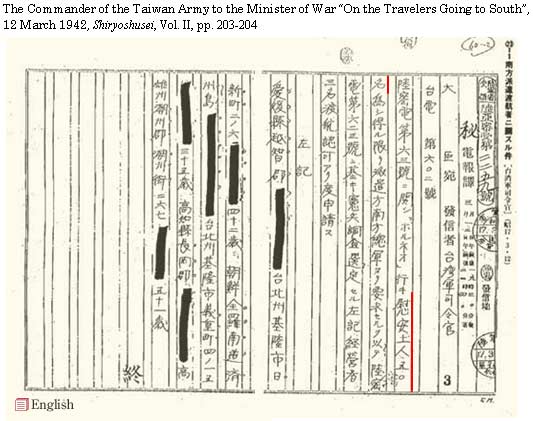 |
Who were the Comfort Women?-The Pacific War and Spreading Comfort Station |
|
|
  |
|
After the Pacific War broke out on 8 December 1941, Japan attacked Singapore, the Philippines, Burma and the East Indies (Indonesia). The military occupation swept south, spreading comfort stations with it. As the occupation widened, it appeared that there was a definite change in the way women were recruited for the comfort stations in the new southern territories. A 14 January 1942 reply from the Minister of Foreign Affairs contained the following sentence: "Because it would not be advisable to issue passports to such types of people going abroad, they should be issued military certificates and transported on ships commissioned by the military." It appeared that the transport of comfort women to those territories came to be under the control of the Japanese military without any intervention of the Ministry of Foreign Affairs, the Home Ministry, and the police. |
|
Sometime between the end of February and the beginning of March 1942, the commander of the Taiwan Army received a message from the Southern Army General Command requesting "50 native comfort women, or as close to that number as possible, to be sent" to Borneo. The commander ordered the military police to conduct a survey and choose three agents. The three agents recruited the women and took them to Borneo.
|
 |
|
|
We can assume that the Southern Army General Command also requested that the Headquarters of the Korea Army send Korean women. According to documents compiled by the U.S. military, the Japanese military headquarters in Seoul contacted agents in May 1942, asking the possibility of recruiting women for "comfort services" in Burma. The agents agreed to do so. The military designated certain agents and apparently had them recruit women. After the recruitment, 703 Korean women were sent in a transport to Burma.
In another document we find that a Korean couple, operating a restaurant in Seoul, were contacted by the military police headquarters. They agreed to take on the job of gathering women and girls and recruited 20 Koreans. With the payment of 300-1000 yen in the currency of that time to their parents, the couple believed that they bought these girls and that they became the couple's own property. This could be considered as the advance payment by which these girls were bound. According to information given by the women and girls, at the time of recruitment, twelve of the twenty recruits were under 21 years of age — one was 17, three were 18, seven were 19, one was 20, and eight were 23 or older. If this information is correct, it would seem to be clear that the conditions stipulated by the Police Bureau, Home Ministry in 1938 for recruitment in Japan were ignored.
It appears that the women and girls were not clearly told they would be required to serve as comfort women.
|
United States Office of War Information, Psychological Warfare Team "Japanese Prisoner of War Interrogation Report", No. 49, Shiryoshusei, Vol.V, pp.203.
The nature of this 'service' was not specified, but it was assumed to be work connected with visiting the wounded in hospitals, rolling bandages, and generally making the soldiers happy. The inducement used by those agents was plenty of money, an opportunity to pay off the family debts, easy work, and the prospect of a new life in a new land - Singapore. On the basis of those false representations many girls enlisted for overseas duty and were rewarded with an advance of a few hundred yen. |
In such cases the agents tricked them, basically recruiting them against their will.
Thus, gathering from the above cited materials, during the Pacific War period, the recruitment of comfort women from Korea and Taiwan was carried down in the following way. On the request of the Southern Army General Command the Korea Army and the Taiwan Army assumed the responsibility of choosing business managers through military police and sending women collected by those managers on military transports to Southeast Asia occupied by the Japanese military. Of course, recruitment of comfort women from Japan was also continued in former way in this period.
Further, in such places as Philippines and Indonesia, native women were made to be comfort women. Research by Professor Aiko Kurasawa shows that the recruitment of comfort women in Indonesia was often done through the heads of residential districts or neighborhood groups. The general pattern seems to have been that village officials would receive a request from the occupying forces, and would act on the request. It was recognized that it was not uncommon for women to be taken against their will.
It is well known that in Indonesia some Dutch women internees were taken to comfort stations. According to Dutch government's report, one third, or one fifth of them were coerced into becoming comfort women. The case at Semarang was tried in a war crime tribunal and a Japanese officer was executed.
When many comfort women worked in comfort stations managed by private managers and set up in city areas and garrison sites, it is recognized that in rural areas many of the native women were raped and abducted to Japanese garrisons buildings and were raped continuously there for a certain period of time. Those victims who suffered most from formidable violence can be also redeemed as anothr comfort women who were forced to provide sexual services to officers and men. In Phillipines, especially, violence against women was frequent.
|
|
  |
|
|
|

